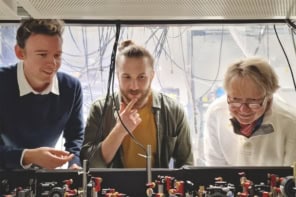
A new measurement, made by an international team of researchers using the world’s most precise clock, shows that the quantum spins of atomic nuclei can help determine an atomic collision’s strength. This phenomenon arises due to a particular type of “spin symmetry” of nuclear spins, the first direct evidence of which has now been found. The finding could help researchers better understand phenomena such as superconductivity and quantum magnetism.
The measurement piggybacks on a recently developed atomic clock based on the element strontium, which has two electrons in its outermost shell. Typically the spins – or magnetic moments – of these electrons point in opposite directions and cancel each other, giving the atoms zero overall electronic spin. This makes electronic spin largely irrelevant for how such atoms interact with each other. Conversely, the strontium nucleus has a non-zero spin – for the isotope strontium-87 this spin can take any of 10 values. But because the nucleus resides in the atom’s centre, inside many layers of electrons, physicists have long thought nuclear spin should not affect how atoms interact when they collide.
Strongly interacting
In 2010, however, theorist Ana Maria Rey at the research institute JILA in Boulder, Colorado in the US, realized that the nuclear spin could have an effect, due to a property called “SU(N) spin symmetry”. According to that symmetry, two colliding atoms with different nuclear spins should interact much more strongly than those colliding with the same nuclear spins, although the particular values of the spins should not matter. No existing device at the time of Rey’s prediction afforded the precision and control needed to measure this effect.
That changed in January 2014, when Rey’s JILA colleague Jun Ye and others reported building a strontium clock that beat all previous clocks in precision and stability. The clock uses a population of weakly interacting strontium atoms cooled to around one-millionth of a degree above absolute zero and trapped in a lattice made by interlacing laser beams. The researchers determined the clock’s tick rate by illuminating the atoms with a red laser at a precise frequency, and averaging the rate of electron transitions between two of the atoms’ quantum-energy states. Rey theorized that this rate should change slightly depending on whether two interacting atoms had the same or different nuclear spins, and that Ye’s newest clock would be sensitive to this change.
Super stability
Ye’s team has now measured the predicted frequency shift. Depending on whether colliding strontium atoms have similar or different nuclear spins, the rate at which Ye’s clock ticked changed by around one part in 1016, which is like adding or subtracting 14 seconds to the age of the solar system. Detecting this minute effect would be impossible without the clock’s ultra-stable laser, which can maintain a coherent quantum state long enough to average the electronic transition frequency over hundreds or thousands of strontium atoms. “That’s really the secret weapon, that we have a laser that can maintain extremely long coherence times,” says Ye.
Understanding and controlling for the spin-symmetry effect will be crucial for building even more precise clocks, one of which will eventually replace the current cesium standard. Beyond better clocks, the team’s methods will also enable physicists to study phenomena that emerge from the quantum behaviour of large ensembles of particles, including superconductivity and quantum magnetism, Ye says. “It’s really fantastic how this clock technology is now used to investigate quantum many-body systems,” says Florian Schreck, a physicist at the University of Amsterdam who calls the result a breakthrough. “I think many people will follow in the steps of this team.”
The work was published in Science.



